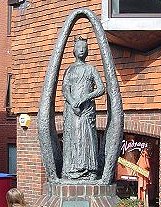Dunstable
Eleanor Cross
Dunstable > Monuments > Eleanor Cross
 Twelve 'Eleanor Crosses' were erected by Edward I when his
wife, Queen Eleanor of Castile died in 1290.
Twelve 'Eleanor Crosses' were erected by Edward I when his
wife, Queen Eleanor of Castile died in 1290.
It was a marriage of convenience (a regular custom in those times) when Eleanor of Castile, just a child of 10, married 15-year-old Edward of Westminster in 1254. Eleanor returned to her family in Spain following the marriage, whilst Edward continued his education - earning his 'spurs' at Tournaments and fighting in wars. When they met again (probably when Eleanor was around 18 years old), it is said that they fell in love, even though their marriage had been a political arrangement rather than a romantic one. They had 15 children, although not all survived into adulthood. They became inseparable and unusually, Eleanor accompanied the King on Crusades to the Holy Lands.
Whilst they were away on Crusade in 1272, Edward's father, King Henry III died. Edward immediately became King of England and Edward and Eleanor were finally crowned on return from the Crusades in 1274.
In 1290, the King was in Scotland awaiting Eleanor's arrival on an important trip, when she was taken ill on the journey to meet him. She was diagnosed as suffering from a 'slow fever'. The Queen was taken to the nearby manor house of Richard de Weston at Harby near Lincoln. The King, on hearing the news, travelled to be at her side but Eleanor failed to respond to treatments and died (it is thought most likely) on the evening of 28th November 1290.
The King wanted her to be buried in Westminster Abbey, so her body had to be taken back to London. This journey took 13 days and followed a route that stopped at several important religious houses including the Priory at Dunstable. When it arrived at Dunstable, the coffin was placed near the crossroads so the local people could mourn the dead Queen. The coffin was then guarded inside the Priory by the Canons overnight before continuing on to St Albans.
To mark each of the over-night stopping places, King Edward ordered that large crosses be erected. Edward probably chose this method of memorial having seen similar crosses in France and other parts of Europe on his travels. Crosses of this nature were erected in the hope that pilgrims and those passing by would pray for the soul of the deceased and so hasten their journey from purgatory into paradise. The resting places for the Queen's coffin and therefore sites for memorial crosses were: Lincoln, Grantham, Stamford, Geddington, Hardingstone, Stony Stratford, Woburn, Dunstable, St. Albans, Waltham Cross, Westcheap and Charing Cross.Only three of the original memorial crosses now remain, at Geddington, Hardingstone and Waltham Cross. These will have been cleaned and possibly repaired over the centuries. The crosses themselves varied in size due to the different designers and builders of the crosses, rather than the importance of the place in which the cross stood.
Sources:
Eleanor Cross, by Bedfordshire Libraries, 2005
Page last updated: 24th January 2014
